
Toyota C-HR SUV Review

Introduction
The Toyota C-HR caused a bit of a stir when it first appeared in 2016. Presented as a cooler, more style-focused alternative to C-segment SUVs like the Nissan Qashqai and Ford Kuga, it found favour with buyers who appreciated bold looks over practicality.
Its dynamic design and hybrid motor options were relatively unusual at the time and helped turn the C-HR into Toyota’s fourth most successful model in Europe. But rivals have caught up and moved on, with petrol/electric power and more ambitious styling on offer across the board.
So Toyota once again has its work cut out to make sure the all-new C-HR can make an impact.
Select's rating score* - 3.9 / 5
At a Glance
One of the big differences between the first-generation C-HR and its rivals was the Toyota’s radical styling, which proved that SUVs don’t have to be big, boxy and boring to win over customers.
So, obviously, Toyota has stuck to the same plan but turned everything up to 11. The new car is wider than before and has shorter overhangs that give it a more solid, aggressive stance. The front end is even bolder, with slim LED lights that carve round and link up with angular black mouldings which encase the deep-set grille. As before, sharp creases run between the wheel arches, but the door handles are now pop-out units for improved looks and aerodynamics.
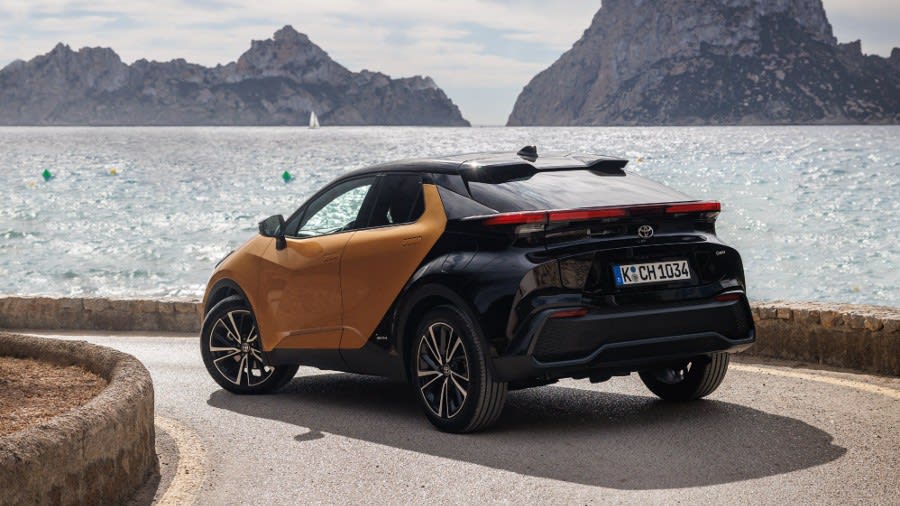
At the back, the C-HR logo is embedded in a full-width LED light bar, and the car’s bold shape is emphasised by the two-tone finish on higher-spec cars, where gloss black D pillars merge seamlessly with the tailgate and roof.
Inside, things are classier than before but less dramatic, while under the skin, the new C-HR offers two hybrid drivetrains, both borrowed from the Corolla and offering 140hp or 197hp, with fuel economy of up to 60mpg. Four core trim levels — Icon, Design, Excel and GR Sport — are joined for the first year only by the Premiere Edition model.
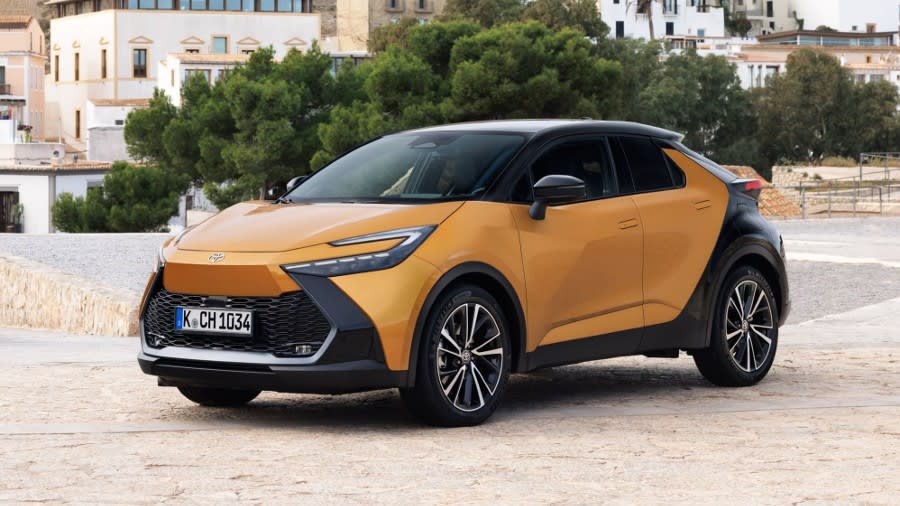
Key Features
Toyota has come in for some flack over its ponderous approach to EVs. A host of battery-powered models are coming by 2026, but the brand insists that hybrid is the right solution to meet current customer demand, hence the hybrid-only engine options in the new C-HR.
Both are from Toyota’s fifth generation of petrol/electric powertrains. The entry-level version is available in the three lower trim levels and uses a 1.8-litre four-cylinder engine and an electric motor to produce a total of 140hp. The top two trim levels have a 2.0-litre engine (with the same electric motor) that boosts total output to a healthier 197hp.
The UK won’t be getting the all-wheel-drive version on sale in other parts of Europe, but in early 2024, we will see the introduction of a plug-in hybrid. That will use the 2.0-litre engine and a more powerful electric motor for 220hp and more than 40 miles of EV range.
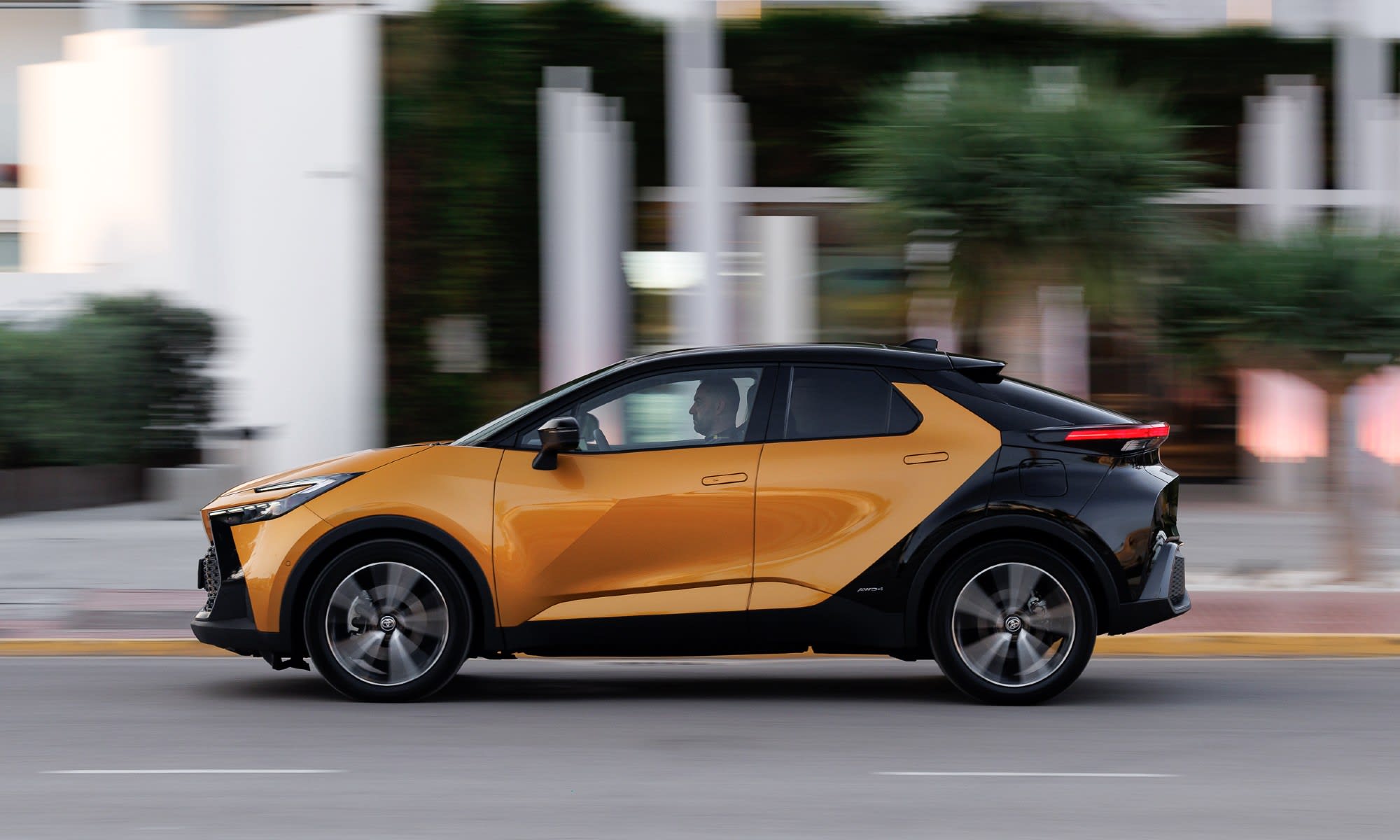
Toyota wants the C-HR to be an “environmental pathfinder” for the brand, so as well as electrifying the whole engine range, a lot of effort has gone into reducing the car’s environmental impact, from lower-carbon production methods and materials to extensive weight-saving measures and using recycled materials around the cabin.
There’s twice as much recycled material than in the old car, and more than 100 parts feature reused content. That includes the seat fabric, which is made from recycled plastic bottles — not that you’d ever guess. Synthetic materials also replace the leather on the steering wheel to aid the car’s sustainability.
Performance & Drive
Although it looks assertive and sporty, the C-HR isn’t really a car for keen drivers.
The 1.8 takes more than 10 seconds to reach 62mph and feels sluggish despite the supposed instant torque of its electric motor. Any sort of heavy throttle is met with a significant pause, then quite a lot of noise, thanks to the CVT transmission, but not much in the way of acceleration.
The system works far better in less demanding circumstances. Cruise around at a steady pace, keep to a part throttle, and don’t ask too much of it, and you’re rewarded with a smooth and refined drive.
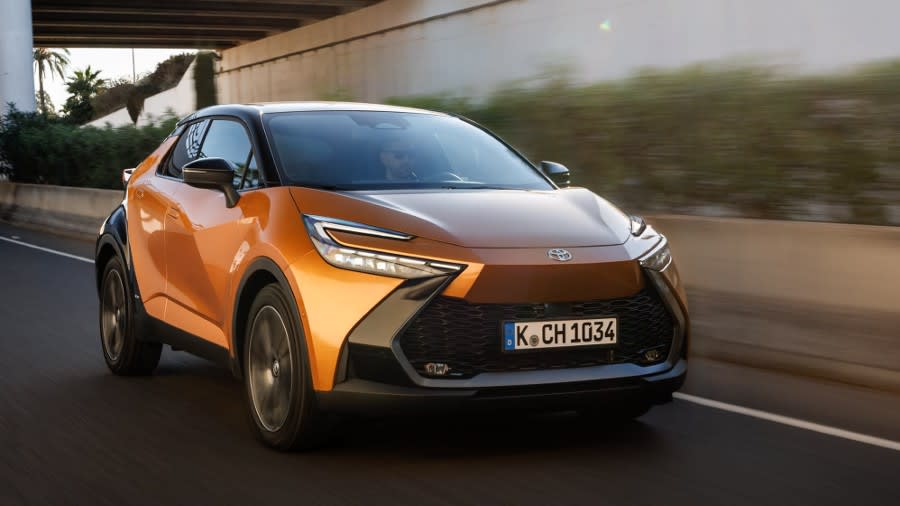
The 2.0-litre is similarly smooth and refined but has an added lick of pace thanks to its extra 60 or so horsepower. That shaves two seconds off the 0-62mph time and brings a quicker response to the throttle, although it’s still not instant and is still accompanied by the drone from the gearbox. And you’ll pay for that extra performance, with the 2.0 only offered in the more expensive GR Sport and Premiere Edition cars.
The new C-HR has been developed in Europe for European tastes, and Toyota says that extends to the car’s handling. New chassis tuning, wider track and frequency-sensitive dampers are intended to bring more dynamism and agility to the C-HR. It certainly feels comfortable swooshing along country roads, but the numb steering and an unavoidable degree of body roll mean driver engagement is still not the C-HR’s forte. Instead, its strongest suit is probably its ride, which, even on 20-inch wheels, is incredibly smooth and composed, regardless of the road surface.
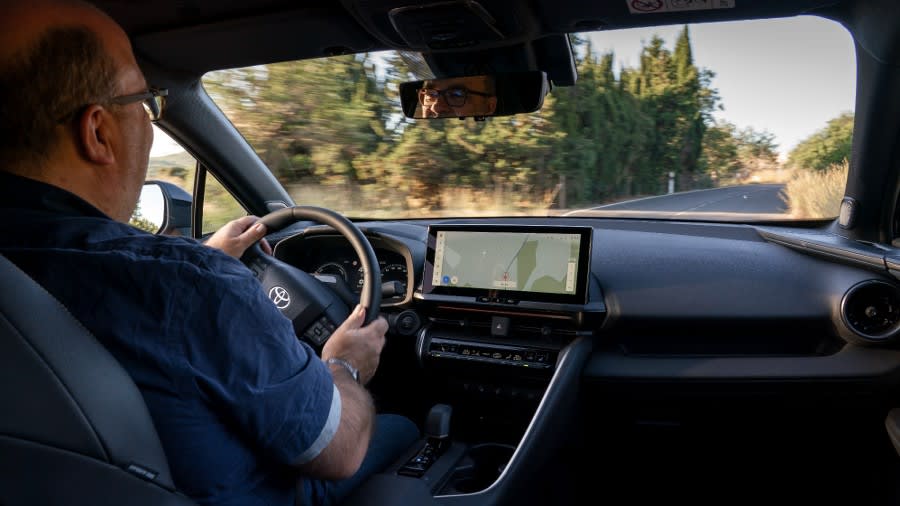
Running Costs
On paper, the C-HR’s fuel efficiency of up to 60mpg is pretty impressive, and on our mixed test route of urban, rural and motorway driving, the car spent nearly two-thirds of its time in electric mode. A Qashqai e-Power can manage only mid-50s, but the Renault Austral, Honda Z-RV and Kia Niro HEV all manage to match or beat the Toyota’s economy.
With CO2 emissions of 105g/km, the 1.8 falls into the 26% BiK tax band, while the 2.0 is in the 27% bracket. For comparison, the Qashqai e-Power is in the 28% band, while the Renault Austral and Kia Niro are in the same band as the Toyota.
Toyota has a bomb-proof reputation for reliability, and there’s no reason to think the C-HR will be any less robust than anything else it produces. For peace of mind, there’s a three-year or 60,000-mile warranty, backed by Toyota’s service-activated cover that can run for up to 10 years.
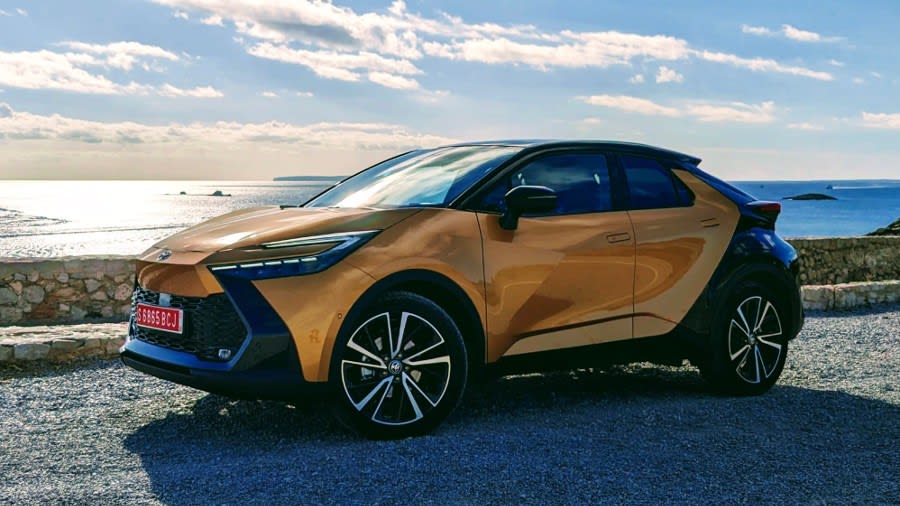
List prices for the C-HR start at £31,290, rising to over £40,000 for GR Sport and Premiere Edition. A mid-spec Design model should be competitive with the likes of the Kia Niro and Volkswagen T-Roc on a monthly payment plan, but Toyota claims the hybrid power could save owners £20 a month over purely petrol rivals.
Interior
While the new C-HR has gone ever further with the bold exterior styling, the interior has taken a step back. The old car’s wild diamonds-on-diamonds-on-diamonds design has been replaced with a more sophisticated but less adventurous look.
The dashboard “wing” sweeps around from door top to door top and is low and flat for good visibility. It features peculiar little panels just at the A-pillar that are a nod towards the more avant-garde look of the old car, but feel a little out of place.
At the centre of the dash sits a 12.3-inch touchscreen (or just 8.0-inch on Icon spec models) that’s bright and sharp but still blighted by an operating system that can’t compete with the best in class. Unlike the old model, where the dashboard swept up and around the screen to integrate it, this one stands out from the centre console like an afterthought. Beneath it, there’s that most welcome of things — a simple bank of physical controls for the air conditioning.
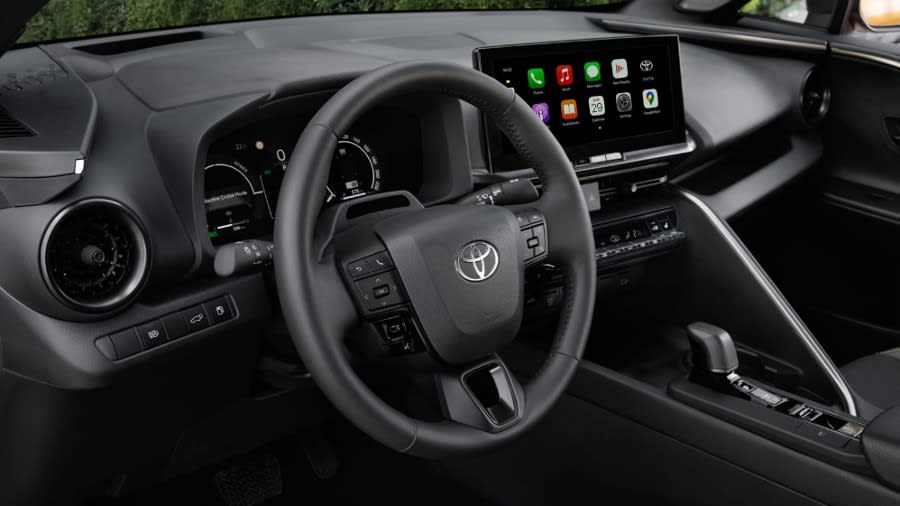
Those controls and the rest of the switchgear all feel like a step forward in quality and easily a match for most other cars in the segment, and it’s nice to see Toyota using more subtle finishes than the shiny black and silver that so many other brands rely upon. The only real touch of flamboyance inside the new C-HR is the ambient lighting strip that runs through the doors and dashboard and offers up to 64 shades of illumination, plus the option to have them adjust depending on the time of day.
One of the big problems of the original C-HR was that sitting in the back felt like being trapped in a postbox. Legroom was tight, and there was virtually no light thanks to a low roof and tiny windows. The new model improves on that massively, with more generous rear windows and a huge sunroof that make the car feel more airy, and an average-sized adult can now fit behind a similarly sized driver with relative ease. There are more practical touches, too, such as better storage and a slightly bigger boot. But it’s still tighter than most alternatives, so you’ll be sacrificing some practicality for looks.
Safety
The C-HR is still to be rated by Euro NCAP, but Toyota doesn’t mess about when it comes to safety, so expect it to get the full five stars. All versions of the car come with Toyota Safety Sense — a suite of active safety and driver assistance systems that range from auto-dipping headlights to cross-traffic alert.
Every specification level comes with pre-crash detection and mitigation, road sign recognition and adaptive cruise control. There’s also blind spot warning and safe exit assist, which warns if passengers are about to open their door into the path of a vehicle approaching from behind. Safety Sense is enhanced in Excel trim with adaptive high beam, lane change assist, front cross-traffic alert, and a driver monitor camera.
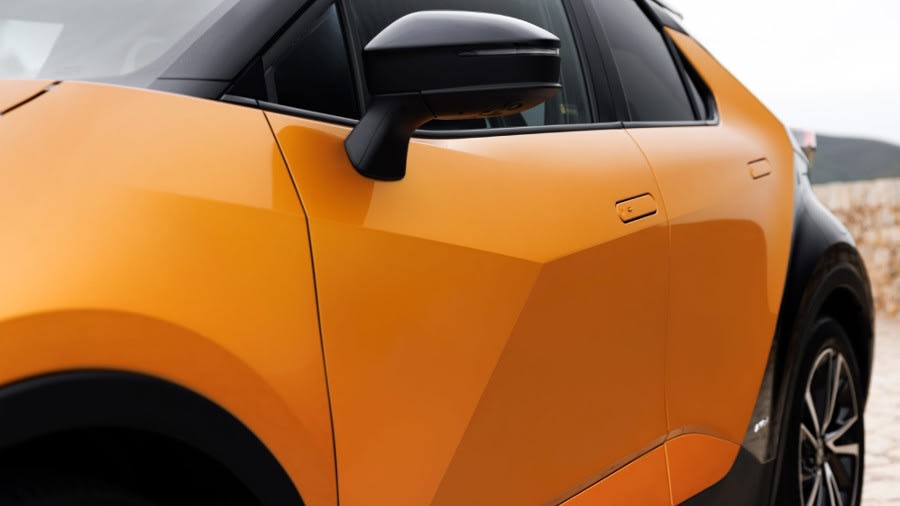
Options
Entry-level Icon cars come with 17-inch alloy wheels, cloth upholstery, a 7.0-inch digital
instrument display and an 8.0-inch multimedia touchscreen with wireless Android Auto and Apple CarPlay. There’s also keyless entry, a reversing camera and the basic Toyota Safety Sense package. The only option available is metallic/pearlescent paint.
Design spec gets bigger wheels and screens — 18-inch alloys and 12.3-inch twin displays — plus dual-zone air conditioning, heated seats, powered tailgate, parking sensors and wireless phone charging. It also unlocks the option to add a panoramic sunroof and bi-tone paint, or select the enhanced Safety Pack and the Premium Pack with its digital key, adaptive high beam, cornering lights, digital rear-view mirror, head-up display and sunroof.
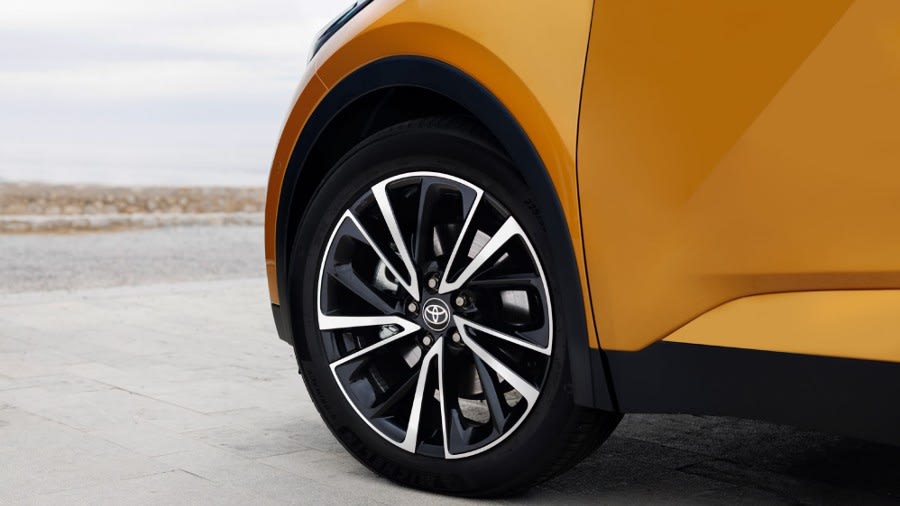
The GR Sport can also be enhanced with the Premium Pack, although it gets 20-inch wheels, a JBL stereo and head-up display as standard.
Exel cars get most of the Premium and Safety Pack features as standard, but the digital key, digital mirror and head-up display are part of a separate Tech Pack. The limited-run Premiere gets the whole lot as standard, plus leather upholstery and an exclusive Sulphur metallic/Astral Black bi-tone finish.
Rival Cars
The Toyota C-HR is in a strange position. Toyota calls it a C-segment SUV, and it’s certainly bigger than something like a Renault Captur or Nissan Juke. But it’s just as clearly less spacious than “regular” C-SUVs like the Qashqai. Toyota’s own predictions have it facing off against the Qashqai, Kia Niro, Volkswagen T-Roc and Peugeot 3008 (below), all of which come with cheaper pure-petrol options as well as similar hybrid variants, and most of which offer more space.
.jpg)
The recently arrived Honda Z-RV, with its 67mpg+ hybrid setup, is another car to consider, although it starts at a significantly higher price. The more traditionally styled Skoda Karoq will also appeal to many. And if you’re more interested in style than space, the Mazda CX-30 is worth looking at, too, although there’s only a mild hybrid option.
Verdict
The second-generation C-HR feels like a worthy successor to its groundbreaking predecessor. It builds on many of that car’s strengths but also suffers from some of its shortcomings.
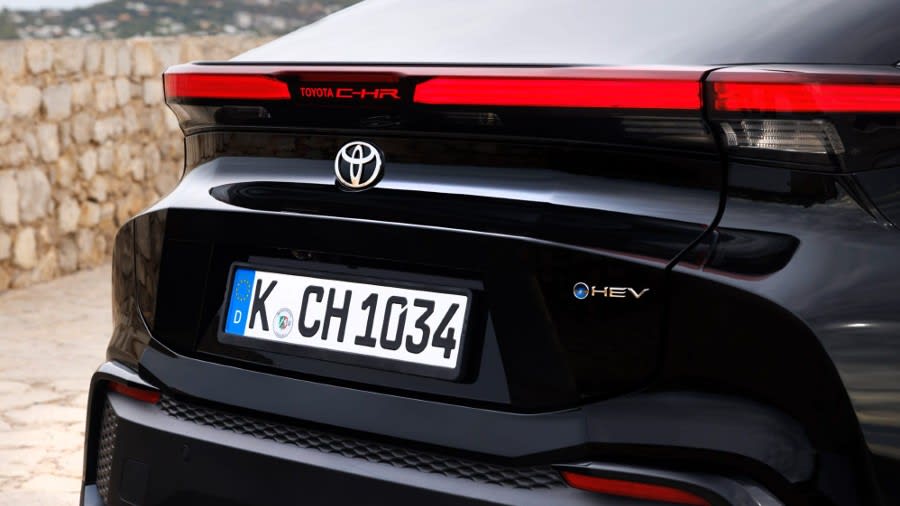
It’s better looking than ever and feels marginally more spacious. The new hybrid drivetrains are impressively frugal, and the on-board technology is a match for most cars in its class. However, the hybrid systems aren’t very responsive and can get quite loud, the cabin feels more cramped than rivals’, and the infotainment system remains a weak link in this tech-heavy car.
Put it all together, and you’ve got a great-looking, competent car, but it’s only good enough to match its rivals rather than pulling clear.
.jpg)
Where to next?
View latest Toyota C-HR lease deals - from just £254 per month ex VAT**.
Call us on 0118 3048 688 or hit the green 'Enquire' button for more details.
Looking for a great leasing deal? Check out our incredible range of Special Offers and Lease Deals.
New SUV? Read our latest Reviews and find the right model for you.
Want to know more about leasing? Take a look at our comprehensive Leasing Guides.
Interested in everything motoring? Why not catch up on all the latest Car Leasing News.
**Score based on Select’s unique meta score analysis, taking into account the UK’s top leading independent car website reviews of the Toyota C-HR.
**Correct as of 21/12/2023. Based on 9 months initial payment, 5,000 miles annually, over a 36 month lease. Initial payment equivalent to 9 monthly payments, or £2,293.29 (Plus admin fee) Ts and Cs apply. Credit is subject to status.


.jpg)

















